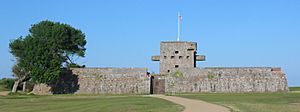83rd Regiment of Foot (Royal Glasgow Volunteers) facts for kids
The 83rd Regiment of Foot was a British army group of foot soldiers. It was also known as the Royal Glasgow Volunteers. This regiment fought for Britain in the American Revolutionary War. It was formed in 1778 and stopped being a regiment in 1783, right after the war ended.
Contents
History of the 83rd Regiment
How the Regiment Was Formed
In 1778, during the American Revolutionary War, a businessman named James Finlay from Glasgow decided to create a new army group. He worked with Mr. Ingram and Mr. Gray to help King George III. Finlay wanted to help his country. He also wanted to help Glasgow's trade, which was suffering because of the war.
On January 26, 1778, a parade marched through Glasgow to find new soldiers. City leaders, drummers, and pipers led the way. James Finlay played the bagpipes. At first, it was hard to find recruits. But soon, many people joined. The regiment quickly reached its full size of one thousand men.
Joining the regiment was attractive because of a large payment. Each new soldier received £30. This was like two and a half years of pay for a private soldier! Some experienced soldiers from the 42nd (Black Watch) Highlanders were moved to the 83rd. However, they were upset because they could not wear their kilts anymore. They protested because of this. Once the group was fully formed, it was called the 'Royal Glasgow Volunteers'. It was given the number 83rd in the army's list of regiments.
Serving in Jersey and New York
After training, the regiment was sent to the Channel Islands in 1778. Their main base was at Fort Conway (now Fort Henry) in Jersey. Half of the regiment stayed there, and the other half went to Guernsey. In total, there were 781 soldiers at this time.
On January 6, 1781, a French force tried to capture Jersey. They landed troops and marched towards Saint Helier. The French were eventually defeated in the Battle of Jersey. During this battle, a special group from the 83rd Regiment, called the Grenadier Company, helped. Led by Captain Campbell, they bravely attacked La Rocque Battery. They took it back from the French. Seven grenadiers from the 83rd were killed in this fight.
Later that year, the 83rd Regiment moved to New York. They stayed there as part of the city's defense until the American Revolutionary War ended in 1783. After the war, the regiment returned to Glasgow. There, it was officially disbanded.
Uniform and Equipment of the 83rd
The soldiers wore the standard army uniform from 1768. This included a red coat with a long tail, a white vest, and white pants. They also wore black gaiters (leg coverings) and black shoes. Their hats were black and folded into a three-cornered shape.
The grenadier soldiers wore tall black bearskin caps. Light infantry soldiers wore a lighter cap and shorter leg coverings. Officers wore a similar uniform. Their coats were made of better red cloth, and they had gold trim. However, they often wore a simpler coat for everyday use.
Two types of buttons were used on their uniforms. One was a round, flat gold-colored metal button. It had the number '83' on it. The other type was a round, pewter button. It also had the number '83' on it.
Regimental Music
The 83rd Regiment had its own special music:
- Grand March of the Royal Glasgow Volunteers
- The Royal Glasgow Volunteer's Jig
- The Royal Glasgow Volunteer's Farewell
Memorial Sites
- Fort Henry, Grouville, Jersey (You can see it from the outside, but it's not open to the public).
- Grenadier's Memorial, Grouville Parish Church graveyard (This is where the seven grenadiers from the 83rd Regiment who died in the Battle of Jersey in 1781 are buried).


